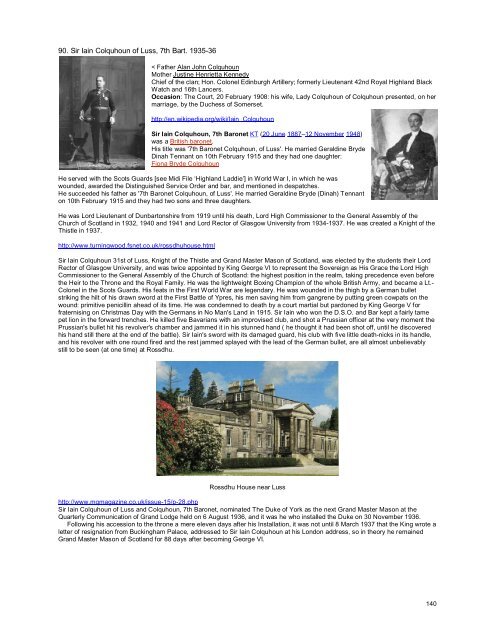Grand Masters of Scotland - Onondaga and Oswego Masonic ...
Grand Masters of Scotland - Onondaga and Oswego Masonic ...
Grand Masters of Scotland - Onondaga and Oswego Masonic ...
Create successful ePaper yourself
Turn your PDF publications into a flip-book with our unique Google optimized e-Paper software.
90. Sir Iain Colquhoun <strong>of</strong> Luss, 7th Bart. 1935-36<br />
< Father Alan John Colquhoun<br />
Mother Justine Henrietta Kennedy<br />
Chief <strong>of</strong> the clan; Hon. Colonel Edinburgh Artillery; formerly Lieutenant 42nd Royal Highl<strong>and</strong> Black<br />
Watch <strong>and</strong> 16th Lancers.<br />
Occasion: The Court, 20 February 1908: his wife, Lady Colquhoun <strong>of</strong> Colquhoun presented, on her<br />
marriage, by the Duchess <strong>of</strong> Somerset.<br />
http://en.wikipedia.org/wiki/Iain_Colquhoun<br />
Sir Iain Colquhoun, 7th Baronet KT (20 June 1887–12 November 1948)<br />
was a British baronet.<br />
His title was '7th Baronet Colquhoun, <strong>of</strong> Luss'. He married Geraldine Bryde<br />
Dinah Tennant on 10th February 1915 <strong>and</strong> they had one daughter:<br />
Fiona Bryde Colquhoun<br />
He served with the Scots Guards [see Midi File ‘Highl<strong>and</strong> Laddie’] in World War I, in which he was<br />
wounded, awarded the Distinguished Service Order <strong>and</strong> bar, <strong>and</strong> mentioned in despatches.<br />
He succeeded his father as '7th Baronet Colquhoun, <strong>of</strong> Luss'. He married Geraldine Bryde (Dinah) Tennant<br />
on 10th February 1915 <strong>and</strong> they had two sons <strong>and</strong> three daughters.<br />
He was Lord Lieutenant <strong>of</strong> Dunbartonshire from 1919 until his death, Lord High Commissioner to the General Assembly <strong>of</strong> the<br />
Church <strong>of</strong> <strong>Scotl<strong>and</strong></strong> in 1932, 1940 <strong>and</strong> 1941 <strong>and</strong> Lord Rector <strong>of</strong> Glasgow University from 1934-1937. He was created a Knight <strong>of</strong> the<br />
Thistle in 1937.<br />
http://www.turningwood.fsnet.co.uk/rossdhuhouse.html<br />
Sir Iain Colquhoun 31st <strong>of</strong> Luss, Knight <strong>of</strong> the Thistle <strong>and</strong> <strong>Gr<strong>and</strong></strong> Master Mason <strong>of</strong> <strong>Scotl<strong>and</strong></strong>, was elected by the students their Lord<br />
Rector <strong>of</strong> Glasgow University, <strong>and</strong> was twice appointed by King George VI to represent the Sovereign as His Grace the Lord High<br />
Commissioner to the General Assembly <strong>of</strong> the Church <strong>of</strong> <strong>Scotl<strong>and</strong></strong>: the highest position in the realm, taking precedence even before<br />
the Heir to the Throne <strong>and</strong> the Royal Family. He was the lightweight Boxing Champion <strong>of</strong> the whole British Army, <strong>and</strong> became a Lt.-<br />
Colonel in the Scots Guards. His feats in the First World War are legendary. He was wounded in the thigh by a German bullet<br />
striking the hilt <strong>of</strong> his drawn sword at the First Battle <strong>of</strong> Ypres, his men saving him from gangrene by putting green cowpats on the<br />
wound: primitive penicillin ahead <strong>of</strong> its time. He was condemned to death by a court martial but pardoned by King George V for<br />
fraternising on Christmas Day with the Germans in No Man's L<strong>and</strong> in 1915. Sir Iain who won the D.S.O. <strong>and</strong> Bar kept a fairly tame<br />
pet lion in the forward trenches. He killed five Bavarians with an improvised club, <strong>and</strong> shot a Prussian <strong>of</strong>ficer at the very moment the<br />
Prussian's bullet hit his revolver's chamber <strong>and</strong> jammed it in his stunned h<strong>and</strong> ( he thought it had been shot <strong>of</strong>f, until he discovered<br />
his h<strong>and</strong> still there at the end <strong>of</strong> the battle). Sir Iain's sword with its damaged guard, his club with five little death-nicks in its h<strong>and</strong>le,<br />
<strong>and</strong> his revolver with one round fired <strong>and</strong> the rest jammed splayed with the lead <strong>of</strong> the German bullet, are all almost unbelievably<br />
still to be seen (at one time) at Rossdhu.<br />
Rossdhu House near Luss<br />
http://www.mqmagazine.co.uk/issue-15/p-28.php<br />
Sir Iain Colquhoun <strong>of</strong> Luss <strong>and</strong> Colquhoun, 7th Baronet, nominated The Duke <strong>of</strong> York as the next <strong>Gr<strong>and</strong></strong> Master Mason at the<br />
Quarterly Communication <strong>of</strong> <strong>Gr<strong>and</strong></strong> Lodge held on 6 August 1936, <strong>and</strong> it was he who installed the Duke on 30 November 1936.<br />
Following his accession to the throne a mere eleven days after his Installation, it was not until 8 March 1937 that the King wrote a<br />
letter <strong>of</strong> resignation from Buckingham Palace, addressed to Sir Iain Colquhoun at his London address, so in theory he remained<br />
<strong>Gr<strong>and</strong></strong> Master Mason <strong>of</strong> <strong>Scotl<strong>and</strong></strong> for 88 days after becoming George VI.<br />
140







![Richard [Nicholls] Harison / Harrison - Onondaga and Oswego ...](https://img.yumpu.com/24950065/1/190x245/richard-nicholls-harison-harrison-onondaga-and-oswego-.jpg?quality=85)
![Richard [Nicholls] Harison / Harrison - Onondaga and Oswego ...](https://img.yumpu.com/24950063/1/190x245/richard-nicholls-harison-harrison-onondaga-and-oswego-.jpg?quality=85)








